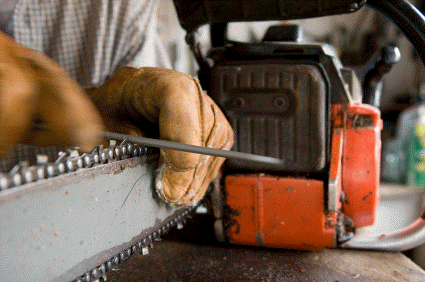Chainsaw Chain
Each segment in a chainsaw chain (which is constructed from riveted metal sections similar to a bicycle chain, but without rollers) features a small sharp blade, called a "tooth." "Skip tooth" chain has a tooth only on every second link, and is used for reduced risk of the chain clogging when cutting very soft wood. In modern saws the teeth are not straight blades; they have a forward section that first chips a piece of wood from the bottom of the cut, then another section, at a right angle to the first, which chips a piece from the wall of the cut. There are left and right handed teeth, depending on which wall of the cut they will chip. Left and right teeth are alternated in the chain.
The underside of each link features a small metal finger that keeps the tooth centered between the rails of the bar, helps to carry lubricating oil around the bar, and engages with the 's drive sprocket inside the body of the saw. The engine drives the chain around the track at a high speed, providing an effective (if rather rough) cutting action.
Cub Cadet Chain
Dayton Chain
Dolmar Chain
ECHO Chain
Efco Chain
Hitachi Chain
Homelite Chain
Husqvarna Chain
John Deere Chain
Jonsered Chain
Makita Chain
McCulloch Chain
Olympyk Chain
Partner Chain
Pioneer Chain
Poulan Chain
Ryobi Chain
Oregon STIHL Chain
Original STIHL Chain
Troy-Bilt Chain
Oregon Chain by Part Number
Chaisnaw Chain By Brand
Craftsman ChainCub Cadet Chain
Dayton Chain
Dolmar Chain
ECHO Chain
Efco Chain
Hitachi Chain
Homelite Chain
Husqvarna Chain
John Deere Chain
Jonsered Chain
Makita Chain
McCulloch Chain
Olympyk Chain
Partner Chain
Pioneer Chain
Poulan Chain
Ryobi Chain
Oregon STIHL Chain
Original STIHL Chain
Troy-Bilt Chain
Oregon Chain by Part Number
